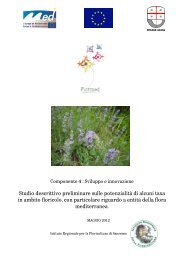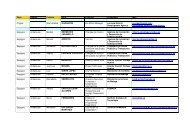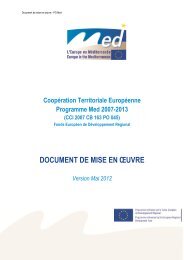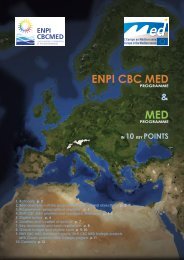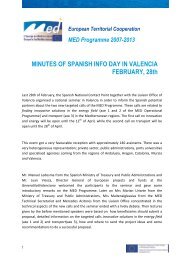MED Communication Handbook - Programme Med
MED Communication Handbook - Programme Med
MED Communication Handbook - Programme Med
You also want an ePaper? Increase the reach of your titles
YUMPU automatically turns print PDFs into web optimized ePapers that Google loves.
proof – particularly when defending yourself against a negative preconception or<br />
promoting a contentious proposition.<br />
Memorise or have to hand “proof points” that validate, illustrate, explain, bring to<br />
life and lend authority to your messages. Proof points can be hard information like<br />
statistics, or soft information like anecdotes and personal stories. They should be<br />
colourful and memorable.<br />
Preparation<br />
Messages and proof points are the foundations of interview preparation. Messages<br />
should be consistent through time, but their details should be reviewed and<br />
customised to the needs of each particular news situation and each particular<br />
interview. Particular interviews will require particular proof points to support the<br />
arguments you are likely to want to make.<br />
A question-and-answer (Q&A) document is often used to crystallise this<br />
process by anticipating all questions that are likely to be asked and preparing<br />
responses that incorporate key messages and proof points to back them up. It is<br />
especially important to prepare for areas of weakness. The list of questions should<br />
include all of the questions that you would least like to be asked, along with the<br />
best possible answers to them. Now is the time to prepare those answers – not off<br />
the top of your head when the journalist asks your nightmare question. Preparing<br />
for and covering your weaknesses in this way is not only practically effective, it is<br />
another great way to boost your confidence for the interview.<br />
A Q&A document is not a script to be memorised. It is obvious to the interviewer<br />
when an interviewee is reading back verbatim prepared answers; this undermines<br />
credibility. To be trusted and believed, you need to be relaxed and spontaneous.<br />
Therefore, a Q&A should be used as a broad guide for the ideas that you need to<br />
communicate, not parroted word-for-word.<br />
Practise, but don’t rehearse. It is very useful to practise for interviews by giving<br />
your list of questions to a colleague and asking them to role-play a probing<br />
journalist. For the same reasons though, this should be viewed as practice and not<br />
rehearsal – you are not preparing precise lines to roll out again later, rather the<br />
goal should be to build confidence, experience, and familiarity with the situation<br />
and the material.<br />
General advice for interviews<br />
Interviews are strange, contrived situations that are unfamiliar to most people who<br />
don’t take part in them regularly or professionally. They can have a similar<br />
dynamic to normal meetings with colleagues at work, or normal conversations or<br />
debates with friends, but don’t be fooled. An interview is a game, an intellectual<br />
4<br />
Factsheet 13: Being interviewed<br />
�



